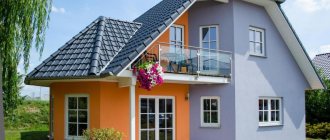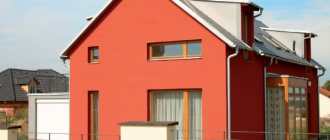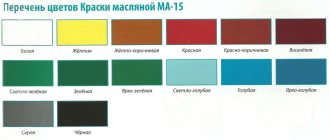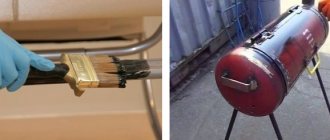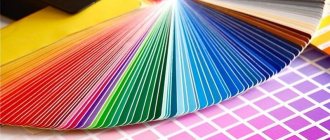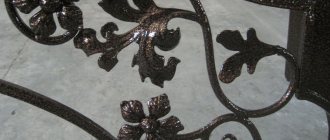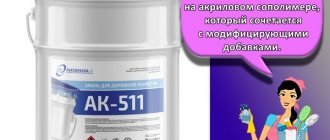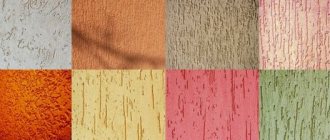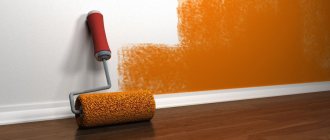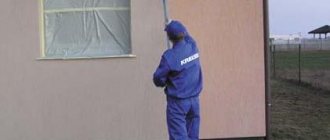Facade paint is a boundary layer that separates wall materials from contact with rain moisture, wind, temperature and other external manifestations.
Regardless of the composition, degree of complexity or other parameters of the walls, the outer layer in most cases is facade paint. It protects the wall materials, creates a decorative effect and gives the house its own appearance , emphasizing the taste of the owner and the architect's plan.
This set of functions requires façade paints to have certain qualities. There are several types of external coatings, one of which should be considered in detail.
Features of silicone facade paint
The basis of silicone facade paints is a water emulsion of silicone resins . This means that facade silicone paint belongs to the category of water-dispersed materials, which gives them certain advantages, but also creates some restrictions and requires compliance with certain working conditions.
In addition, the mixture contains various additives, fillers or pigments that give the coating strength, speed up drying and perform other special tasks.
According to its basic parameters, silicone paint is excellent for outdoor use. The coating provides the necessary vapor permeability, water protection, and has high elasticity.
The basic composition of silicate facade paint has a pure white color; to obtain the required shade, the mixture is tinted - the necessary pigments are added to it, giving the required color. The matte surface creates a strong decorative effect - the paint layer does not glare in the sun, the wall plane looks perfectly smooth.
A distinctive feature of water-dispersed paints is the absence of odor during application . This is an important circumstance that significantly makes life easier for all people who find themselves nearby - from the residents of the house or neighbors, to the painters themselves, who receive the maximum amount of emissions from the applied compounds.
Another important property of silicone compounds is their inherent “lotus effect”. That is, the surface has high water-repellent qualities and dirt or dust does not stick to it . In any case, a little rain is enough to completely clean the walls of the house.
A layer of silicone facade paint does not require any maintenance, does not require periodic application of various compounds, etc.
Main manufacturing companies
Paint manufacturers strive to achieve two goals: optimize paint quality and maintain the mid-price segment. Silicone paint is a water-based paint.
Tikkurila
It is a guarantor of the quality of finishing work. The paints are distinguished by their purity of color, environmental friendliness, and comfortable technical characteristics. Purchasing an original Finnish product guarantees high quality. Paint made in Russia often does not match the quality level of the Finnish manufacturer. It is difficult to find negative reviews for the brand. The disadvantage is the high price of the company's products.
Caparol CapaSilan
professionals can paint the surface in one layer in one layer due to the high hiding power of the paint caparol is one of the rare companies specializing in the production of paints and varnishes in a silicone base; the paint resists aggressive chemical substances and has a high repellent effect
Litokol Litotherm Paint Sil
The paint has premium qualities. Offers a wide range of color options, is highly resistant to harsh atmospheric conditions, and reliably protects the facade from moisture, dirt and ultraviolet radiation. Paint developers provide for the preliminary use of plaster, putty and primer from the same manufacturer, otherwise the finishing coat is of lower quality.
Baumit Silikat color Repro
The paint is considered an elite material from an Austrian manufacturer based on liquid potassium glass. The material is highly resistant to ultraviolet radiation, dirt, aggressive chemicals, and has high vapor permeability. The price is lower than other brands, the downside is the high consumption, reaching 500 grams per 1 square meter, as well as the limitation on operating temperature. It does not exceed 8 degrees Celsius.
Ceresit CT54
The product is characterized by high hiding power at a low price and economical consumption. The German manufacturer is a guarantor of the quality of finishing work. Disadvantages include the need for ideal surface preparation using mineral-based materials.
When using silicone paint, expiration dates must be strictly observed. The organic compounds included in the composition significantly affect the quality of the color.
The price of paint can be reduced by adding other additives. It is important to understand that durability and wear resistance depend on the amount of resin.
Differences from other types of facade paints
Unlike all other exterior paints, silicone compounds have the highest degree of elasticity. The coating layer does not form cracks with small changes in the linear dimensions of the base.
This makes it possible to hide the shrinkage of the house, calmly tolerate vibrations, seismic soil movements, etc.
Repair compositions of silicone paint have increased hiding power; they are capable of sealing cracks up to 2 mm wide.
Silicone compounds have a high thixotropy index. This property is characterized by an increase in the viscosity of the composition at rest.
Convenient quality when working with a roller or brush - the paint rolls off the tool less, the process becomes more accurate, and fewer stains or drops of paint remain.
In addition, silicone facade coatings have a high degree of alkali resistance . In practice, this means that it is possible to paint the surface within 48 hours after applying the outer layer of plaster, while other paints can be applied only after a month, in order for all the curing processes of the cement compositions to be completed.
Key Benefits
Among the advantages of silicone paint are:
- Safety for human health. The absence of odor does not require the use of respiratory protection when working outdoors near a house or in an apartment. There is no need for a constant flow of fresh air in the room where painting takes place.
- Wide range of colors achieved using tinting.
- Versatility, making it possible to apply the composition to any surface. It is possible to process walls made of brick, concrete, wood.
- Durability, allowing painted facades to look like new for 20-25 years.
- Resistance to mechanical damage due to the resins and additives present in the composition.
- Convenience and ease of work as with any water-based paint.
Resistant to dirt and external influences
Silicone facade paint has this quality due to its self-cleaning ability. Manufacturers call it the “lotus effect”, in which any liquid flows from the petals.
The additives included in the product help form a protective film through which drops flow over the surface and wash away dirt and dust from it.
The more similar components there are, the more pronounced the self-cleaning property is. However, this ability does not appear immediately, but a month after treatment.
Advantages and disadvantages
The advantages of silicone coatings include:
- High elasticity.
- Frost resistance.
- Compatible with most bases.
- The water-repellent ability of the surface prevents the adhesion of dirt or dust.
- No characteristic paint odor during application.
- Strength, abrasion resistance, wear resistance.
- Resistance to biological influences - the appearance of mold, mildew, etc.
However, there are certain disadvantages:
- High cost of paint.
- The need for tinting in the desired color, the lack of ready-to-use color compositions.
IMPORTANT!
The price of paint is to some extent compensated by the absence of the need for repeated repairs, since the durability and strength of the coating are very high.
Specifications
Silicone-based paints have a fairly wide range, so the average values will be listed:
- Operating temperature - from -50° to +70°.
- Temperature for application - from +5° to +30°.
- Density - 1.5 kg/cubic dm.
- Frost resistance - up to 100 cycles.
NOTE!
The frost resistance indicator is calculated, not tested in practice.
- The surface is resistant to rain 3 hours after application.
- Drying time - 3 hours for setting, 8-9 hours for complete drying of 1 layer, 12 hours for further processing.
- Covering capacity (min) - 120 g/sq.m.
- Thinner: water, not more than 5%.
Recommendations for using silicone paints
Some tips will be universal, suitable for both regular mixtures and silicone ones. But you need to understand that the structure of this building material is slightly different, so you need to take an appropriate approach to its use. Let's consider our recommendations.
- Application of silicone paint is carried out strictly within the warranty period. It contains organic compounds that lose their properties.
- Paint with fewer chemical compounds is considered to be of higher quality, but costs more, pay attention to this when choosing.
- Pay attention to the percentage of electrical conductivity if this indicator is very important to you when painting metal. Each manufacturer makes different mixtures and they can vary greatly.
- The consumption of silicone paint for exterior work should be slightly increased - 0.4 l per 1 sq.m. It is not advisable (but possible, if necessary) to apply paint to a wet surface.
- You won’t be able to use a spray bottle, the consistency of the paint won’t allow it, or you need to take equipment with a large nozzle and good pressure.
The price of silicone paint can be reduced by diluting it with other mixtures, but it is worth understanding that the less resin it contains, the less durability it will have for outdoor use. Stirring is only relevant for internal use.
Main types and companies
Silicone compounds are manufactured by almost all leading companies engaged in the production of such products.
The following brands can be specified:
- Tikkurila.
- Finngard.
- Ceresite.
- Alpina.
- Snowball.
From Russian:
- Façade.
- Halo.
- Admiral, etc.
It should be understood that the fact that any composition belongs to a well-known brand does not mean full compatibility with this particular material, therefore it is necessary to take into account the operating conditions and base material.
What surfaces is it suitable for?
Silicone facade paints can be applied to almost any type of substrate:
- Concrete.
- Brick.
- Plaster (sand-cement, textured, etc.).
- Old coatings (optimally silicone), subject to compatibility in chemical composition.
Water-dispersed compositions do not adhere well to old coatings that have a greasy surface or were previously coated with oil mixtures.
Such coatings must be removed before applying silicone materials; before application, a layer of deep penetration silicone primer must be applied for better adhesion.
Facade paint for plaster, concrete and brick
Flugger's line of facade paints for plaster, brick and concrete includes all types of necessary coatings for various types of surfaces and substrates. A common and very important feature for the entire line is good vapor permeability.
When used correctly and with proper preparation of the base, Flugger products can protect facades made of various materials for many years, up to 20 years. With Flugger, choose the right material that meets your goals and requirements, and you will forget about repairs for many years.
Paint consumption per 1 sq.m.
The average consumption of silicone facade paints declared by manufacturers is 150-200 g/sq.m . (some sources indicate much larger values - from 0.3 to 0.6 kg/sq. m.).
However, in practice the values may differ from those indicated on the packaging. The reasons for the discrepancies are that the working conditions on the site differ significantly from the situation in the factory laboratory; the quality of the base, absorbency and other application conditions cannot be exactly the same.
In addition, the consumption is affected by the viscosity of the paint, especially considering the fact that thick compositions are often used to obtain textured surfaces.
In addition, it is necessary to take into account the difference in viscosity of the composition for the first and second layer . If the first layer is made thicker, then the second is usually diluted with the required 5% water, which reduces consumption.
CAREFULLY!
When calculating the required amount of material, it is necessary to take into account the number of layers, and the resulting amount of material must be increased by 15-20% to compensate for possible losses.
Calculation of the amount of paint per m2
Manufacturers indicate on the packaging of silicone paint the minimum consumption per square meter, it is in the range of 150-600 ml, the average consumption is 200 ml. Practice shows that the consumption coefficient of finishing material per square meter is determined by the following factors:
- paint viscosity level;
- type of surface intended for finishing;
- surface structure;
- paint thickness.
When calculating the total paint consumption for finishing, you need to find out the surface area and take into account how many layers the consumable material will be applied.
Note! Even if accurate calculations of consumption have been made, you need to buy 20% more material, because no one is immune from unforeseen situations.
Preparing the surface for application
Before applying paint, it is necessary to thoroughly prepare the surface of the walls. To do this you should:
- Remove all hanging elements - lanterns, brackets, trims, billboards, signs, etc.
- Inspect the walls, determine the number of flaws - cracks, potholes, crumbling or peeling.
- Detected irregularities must be sealed using putty . If the flaws are too significant, then you will have to apply a continuous layer of plaster, especially for walls with a lot of crumbling.
The plaster layer should be dried, and a layer of deep penetration primer should be applied (use compounds that are most suitable for contact with silicone coatings).
Preparing the base before painting
A properly prepared base has a decisive influence on the finishing and final result. If the base is prepared taking into account all the rules, then the topcoat will serve you for many years, and if we are talking about high-quality paint and varnish products, then the service life can be 10, 15, 20 years. This stage is necessary both for already painted substrates and for new ones.
Padding
Always, when preparing the base, prime each layer with a special primer for facades. Do not use universal, cheap and primer for interior work. Before you buy a certain type of facade paint, look at what type of primer is needed for this product. Mineral and water-dispersed ones use their own primer compositions.
- Priming the base promotes uniform absorption and drying of moisture, increases adhesion and adhesion to the base.
- The primer helps reduce the consumption of the paint layer on the surface; the wall will not absorb much.
- The composition will be easier and easier to roll out over the surface.
- Before priming, it is necessary to double-check the hardness and strength of the base. The plaster should not spill out or chip easily, otherwise over time the finishing coating will simply peel off. Simply stick the tape to the surface and tear it off after a while to check. When torn off, the tape should come off without any putty or plaster.
Painting over a new plastered wall
After you have completed all the plastering work, you need to let the base dry thoroughly and settle. It is not recommended to apply façade paint for exterior use over damp, damp plaster and an undried base. For the surface to dry completely, wait at least two, three weeks or more.
It is also necessary to take into account weather conditions, precipitation and air humidity. If you start painting work on a surface that has not dried, you risk getting uneven color and poor adhesion to the base.
Application over old coating
Before applying fresh facade paint, it is recommended to check the condition of the previous paint layer and the base itself for the presence of peeling, damage, cracks, and swelling. All damage to the old paintwork must be removed, cleaned, washed off, cracks and chips must be filled. Wash the surface with special detergents. Then rinse off the remaining detergent and other dirt using plain water.
After the surface has completely dried, you can apply a primer. Then, once again, allow the surface to dry completely. Next, the final paint layer is applied, in accordance with the type of previous coating. It is recommended to paint in at least two layers for more uniform coloring and better protection.
Note
- the southern and western sides are most exposed to the sun, ultraviolet rays, so they can deteriorate faster.
- the northern and eastern sides are generally more durable, but moisture is more likely to accumulate on them, which contributes to the formation of fungus and mold.
- remember that acrylic facade paint is not applied to surfaces previously painted with alkyd and other organic paints and varnishes.
- For aqueous solutions, a water-based primer is used, and for silicate solutions, a special silicate primer is used.
- It is not recommended to carry out painting work during precipitation.
- Do not paint in direct sunlight or strong wind.
- If you want to get the most environmentally friendly and fireproof surface, we recommend that you use water-based materials.
- In order to obtain the most moisture-resistant, stain-resistant surface with high-quality vapor permeability, use silicone-based dyes.
- If you have a new house, a freshly plastered facade, and you have not decided on the choice, then in your case, acrylic facade paint will be the right choice, since it is the most versatile paint and varnish product at the moment.
Remember that initial painting work or facade repair is a very expensive job, therefore, when purchasing any products for exterior work, remember that you should not run after a cheap, well-promoted brand if you want your facade to last at least 10 years without repairs.
The cost of facade paint directly depends on the quality of the binding components included in the composition. If you do not want to carry out repair work on the facade every couple of years, then we recommend that you do not follow the principle of “the miser pays twice.”
Always properly prepare the substrate before painting. Use specialized primers. Follow all painting technology of this manufacturer.
If you do not know what composition you want to treat the building with, then in this case we recommend acrylic facade paint from a trusted manufacturer. Water-based acrylic-based paint compositions from Flugger are the most versatile and environmentally friendly.
Tinting paint
Tinting is the process of combining a base composition with a specific pigment or tinting paste.
This operation can be carried out either centrally - when ordering the required amount of paint from the seller, you can immediately resolve the issue of tinting the desired color - or independently.
In order to tint paint, you need to mix the base composition with a certain amount of pigment (tinting paste).
In practice, this is achieved by simply adding a certain amount of pigment to a container with paint and thoroughly mixing the contents until a completely homogeneous mixture is obtained.
If it is necessary to finish large areas, you must carefully monitor the amount of pigment added so that all containers have the same shade.
Tinting
A large selection of colors and the ability to adjust the color intensity allows you to choose the color of the facade to suit every taste, making it absolutely individual. Pre-painted paints are few in number; tinting is the optimal solution. Compliance with the rules guarantees stability and color saturation:
- paint and colors are selected from the same manufacturer;
- base paint contains a large amount of white pigment;
- the amount of color does not exceed 20% of the total volume of paint, a higher pigment content reduces water resistance and service life;
- compliance with strict proportions of colors and base for painting the entire facade.
Coloring technology
The required color is poured into a tank of white paint. The mixture is mixed with a mixer until smooth. Manual stirring is not recommended due to possible residues of undissolved pigment particles on the bottom and walls of the container.
Technology of painting facades with silicone paint
To apply façade paint, certain conditions are required:
- Air temperature ranges from +5° to +30°.
- Dry weather (no rain).
- There is little or no wind.
- Direct sunlight is undesirable (usually forests are covered with a special net).
The material is applied manually (with a brush or roller) or mechanically (spray gun) . If the surface absorbs the material well, it is recommended to apply the first layer with a thinner consistency, then the second layer will lie smoother, without noticeable stains.
It is recommended to do 2 layers in total , although in each specific case they are guided by the result obtained and determine the required number of layers on the spot.
After applying the first layer, the surface must be left to dry for 2-4 hours , after which the second layer can be applied. The final drying of the coating occurs after 12 hours.
Silicone facade paint is an excellent exterior coating for walls, having high performance qualities, compatible with almost any type of substrate, and having high elasticity, vapor permeability and water-repellent properties.
This combination of qualities could make the material the most preferred, but the high cost of production reduces demand among users. However, the material successfully competes with any type of exterior coating, creating a stylish and highly aesthetic appearance for the home.
Surface painting procedure
For quality work, you need to choose the right tools:
- roller for a flat wall;
- brush for relief plaster, brickwork and wooden partitions;
- spray gun - if possible for any surface.
Finishing is carried out in dry weather at an air temperature of +5...+30 °C and no wind.
The wall or façade must be treated in 2 layers. The first should be liquid for a more even color of the base coat, which is applied after the previous one has completely dried (after 2-4 hours). The process for interior and exterior work is identical:
- First, use film or masking tape to protect parts that do not need painting.
- When working on the ceiling, the floor must also be covered with paper or polyethylene.
- Pour the paint into a special container (a wide, flat tray is best).
- After dipping, squeeze out the bristles of the brush or the coat of the roller to avoid the formation of smudges.
- Paint the walls from bottom to top, and the ceiling from the corner opposite the window.
- Use a narrow brush in hard-to-reach places.
- If any defects are found, apply a second finishing coat after the first has dried.
The spray gun allows you to uniformly paint any surface.
